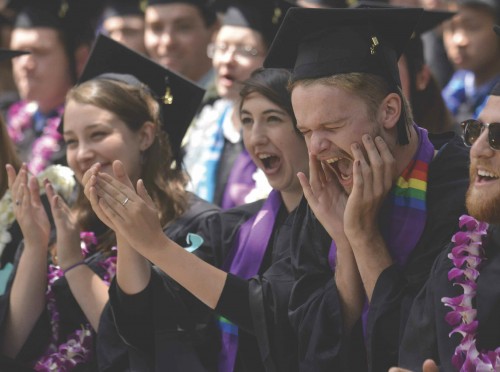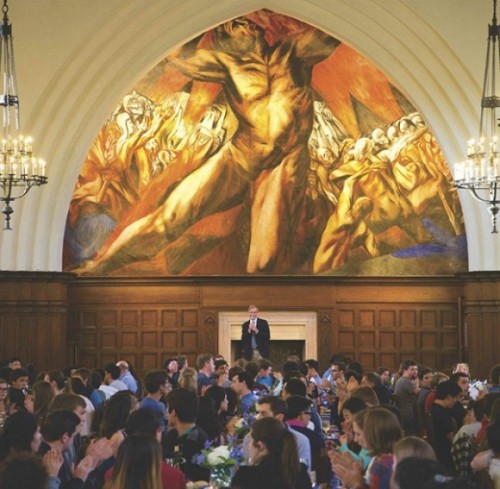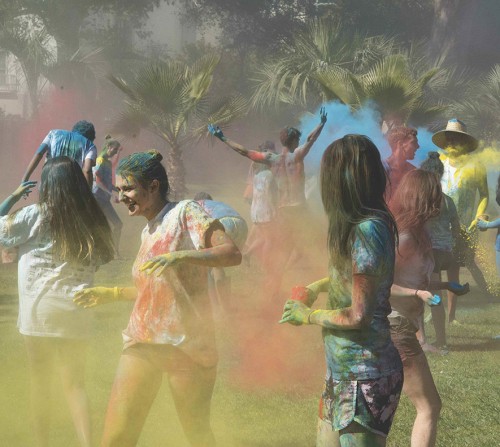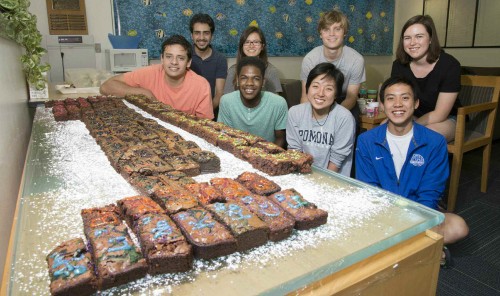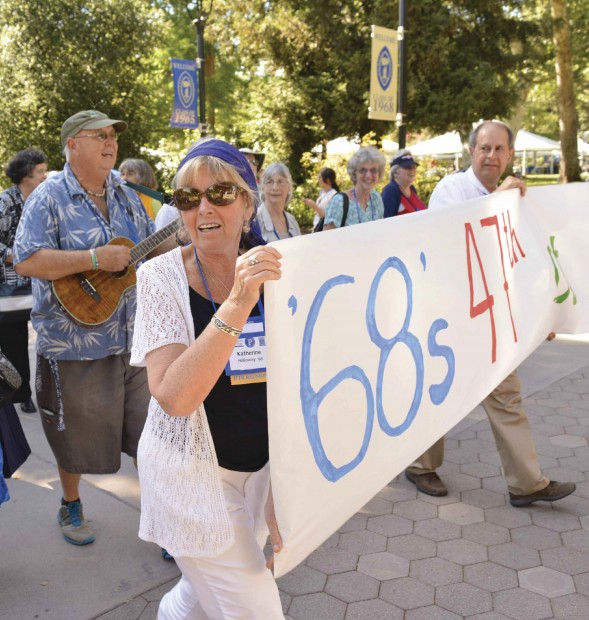
THE CLASS OF 1968, which launched the College’s ongoing fascination with the number 47 years ago, has now given birth to a new tradition—the 47-year reunion. During Alumni Weekend, members of the class flocked back to Pomona for the first such gathering, and in honor of the occasion, they even created a new genre of poetry, which they dubbed the “tetrasept.”
At the center of it all was Bruce Elgin ’68, who—as a student in class with Professor Donald Bentley back in 1964—was one of originators of Pomona’s ongoing 47 search (along with Laurie Mets ’68). Elgin defines a tetrasept as a poetic form with “either four lines of seven syllables or seven lines of four syllables,” adding: “There are no rhyme or meter restrictions.”
During the build-up to the reunion, members of the class submitted tetrasepts about the reunion itself, the Class of ’68 or the cult of 47, for publication in a 32-page booklet. The submissions ranged from nostalgic to acerbic to esoteric, but they had one thing (in addition to their unique form) in common—they’re characteristic of the extraordinary inventiveness of one of Pomona’s most innovative classes.
Below are a few examples lifted from the booklet titled “Tetrasepts.”
From “Tetrasepts”
We call four score and seven
Oratory from heaven.
But other way ’round … not close:
Seven score and four—just gross!
—Bruce Elgin ’68
Greetings dear friends,
the deadline nears.
Words elude me.
What did I learn
at Pomona?
Procrastinate,
and words will come.
—Karen Porter MacQueen ’68
Why wait ‘til number fifty?
Let’s meet now, and let’s meet then.
Twice the fun! (Like letters here
Are two times forty-seven).
—Ruth Massaro (Henry) ’68
Forty-seven
Since sixty-four
Has proved to be
Unlikely lore;
So now ’hens fete
What shall endure
Forever more.
—Mary Jane Gibson ’68
Forty-seven
Have come and gone
My liberal
Education
Still a solid
Deep foundation
For a good life.
—Jill Kelly ¸’68
Where art thou forty-seven
Our class seeks you everywhere
In proofs, in ads, or even
A silly verse—on a dare.
—Diane Erwin ’68
They only are loyal to
this college who, departing,
bear their added riches in
trust for mankind. James Blaisdell
—Kathleen Wilson Selvidge ’68
Bentley proved all
Numbers equal
Forty-seven;
Hence Pomona
Class reunions
Always are the
Forty-seventh.
—Brian Holmes ’68

 The spring tour of the Pomona College Glee Club took them to a range of performance spaces, from a high school gymnasium in New York’s Washington Heights to a retirement community in Stamford, Conn., to the Church of the Holy Trinity in Philadelphia. However, the undisputed highlight of the tour was a half-hour concert in the National Cathedral in Washington, D.C.
The spring tour of the Pomona College Glee Club took them to a range of performance spaces, from a high school gymnasium in New York’s Washington Heights to a retirement community in Stamford, Conn., to the Church of the Holy Trinity in Philadelphia. However, the undisputed highlight of the tour was a half-hour concert in the National Cathedral in Washington, D.C. Drought is changing the face of Southern California, as more and more green lawns give way to desert plantings requiring a fraction of the water. At Pomona, turf removal hit a new high this summer, with the replacement of an additional 140,000 square feet (3.4 acres) of grass, according to Head of Grounds Kevin Quanstrom. Among the swaths of grass to be removed were areas around Alexander, Oldenborg, Hahn and Wig halls. Grass-lovers can take heart, however, that the broad, grassy lawn of Marston Quadrangle will remain green—at least for now.
Drought is changing the face of Southern California, as more and more green lawns give way to desert plantings requiring a fraction of the water. At Pomona, turf removal hit a new high this summer, with the replacement of an additional 140,000 square feet (3.4 acres) of grass, according to Head of Grounds Kevin Quanstrom. Among the swaths of grass to be removed were areas around Alexander, Oldenborg, Hahn and Wig halls. Grass-lovers can take heart, however, that the broad, grassy lawn of Marston Quadrangle will remain green—at least for now. It’s early May, and Pomona students are stressing out in droves over final papers and upcoming exams. But never fear—help is near, with a wagging tail and a droopy ear. During the annual “De-Stress” event on the Smith Campus Center lawn, students take a little time off from studying to do something that is medically proven to reduce stress—that is, pet a puppy. For those allergic to doggie fur, the event also includes games, frozen snacks and plenty of pizza and camaraderie.
It’s early May, and Pomona students are stressing out in droves over final papers and upcoming exams. But never fear—help is near, with a wagging tail and a droopy ear. During the annual “De-Stress” event on the Smith Campus Center lawn, students take a little time off from studying to do something that is medically proven to reduce stress—that is, pet a puppy. For those allergic to doggie fur, the event also includes games, frozen snacks and plenty of pizza and camaraderie.